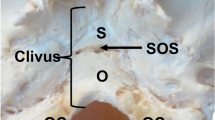Abstract
In 1960, Holtermüller and Wiedemann described chondrodystrophic hydrocephalus as Kleeblattschädel syndrome. In the present paper, we review 23 cases of this syndrome associated with hydrocephalus, including 2 cases of our own. Of these 23 cases, 8 involved communicating hydrocephalus and 15 non-communicating hydrocephalus. It has been speculated that the associated hydrocephalus results from basilar impression, compression of infratentorial structures, aqueductal stenosis in non-communicating hydrocephalus, and impairment of venous drainage and cerebral spinal fluid flow at the level of the constrictive cranial ring in communicating hydrocephalus. Our present cases also showed this cranial ring, as demonstrated by skull X-rays and computed tomography scans. Since cloverleaf skull syndrome often has other general anomalies, we consider the hydrocephalus in this syndrome to have causes associated wtih the osteocartilaginous system.
Similar content being viewed by others
References
Andoh T, Yokoyama K, Kumagaya M (1984) Cloverleaf skull syndrome: case report with a review of the literature (in Japanese). Nerv Syst Child 9: 333–341
Angle CR, McIntire MS, Moor R (1976) Cloverleaf skull: Kleeblattschädel deformity syndrome. Am J Dis Child 114: 198–202
Arseni C, Horvath L, Ciurea V (1972) Cloverleaf skull. Acta Neurochir (Wien) 27: 223–230
Burkhardt L, Fisher H (1970) Pathologische Anatomie des Schädels. In: Henke F (ed) Handbuch der speziellen pathologischen Anatomie und Histologie. Springer, Berlin Heidelberg New York, pp 116–117
Comings DE (1965) Kleeblattschädel syndrome. J Pediatr 67: 126–129
Eaton AP, Sommer A, Sayers MP (1975) The Kleeblattschädel anomaly. Birth Defects 11: 238–246
Golabi M, Edwards MSB, Ousterhout DK (1987) Craniosynostosis and hydrocephalus. Neurosurgery 21: 63–67
Hoffman HJ, Hendric EB (1979) Early neurosurgical repair in craniofacial dysmorphism. J Neurosurg 51: 796–803
Holtermüller K, Wiedemann HR (1960) Kleeblattschädel-Syndrome. Med Monatsschr 14: 439–446
Liebaldt G (1964) Das Kleeblattschädel-Syndrom als Beitrag zur formalen Genese der Entwicklungsstörungen des Schädeldaches. Ergeb Allg Pathol Pathol Anat 45: 23–38
Morooka T, Iyamae S, Maruki K (1977) A case of cloverleaf skull syndrome with persistent cerebrospinal fluid rhinorrhea (in Japanese). No To Shinkei 29: 1059–1066
Müller PJ, Hoffman HJ (1975) Cloverleaf skull syndrome. Case report. J Neurosurg 43: 86–91
Partington MW, Gonzales-Crussi F, Khakee SG, Wollin DG (1971) Cloverleaf skull and thanatophoric dwarfism. Arch Dis Child 46: 656–664
Rogers GL, Penland W, Sayers MP (1981) The management of the Kleeblattschädel syndrome. Ann Ophthalmol 13: 1173–1175
Saji S, Misao A, Hirose T, Funakoshi T, Yamad H, Kunieda F (1977) The cloverleaf skull syndrome: report of 2 cases and review of the literature (in Japanese). No To Shinkei 29: 389–397
Sano J, Sasaki Y, Shimada H, Misugi K, Kagyo H (1982) Cloverleaf skull syndrome. An autopsy case and review of the literature. Acta Pathol Jpn 32: 887–900
Scarfó GB, Tomaccini D, Gambacorta DG, Capaccioli L (1979) Contribution to the study of craniostenosis; disturbance of the cerebrospinal fluid flow in oxycephaly. Helv Paediatr Acta 34: 235–243
Takano S, Enomoto T, Onizuka H, Nose T (1989) Cloverleaf skull syndrome with occipital bone cristae (in Japanese). Neurol Med Chir (Tokyo) 29: 746–752
Wodarz R, Sorensen N, Ratzka M (1979) CT-findings in a case of cloverleaf skull. Eur J Pediatr 131: 75–79
Zuleta A, Basauri L (1984) Cloverleaf skull syndrome. Child's Brain 11: 418–427
Author information
Authors and Affiliations
Rights and permissions
About this article
Cite this article
Shiroyama, Y., Ito, H., Yamashita, T. et al. The relationship of cloverleaf skull syndrome to hydrocephalus. Child's Nerv Syst 7, 382–385 (1991). https://doi.org/10.1007/BF00304202
Received:
Revised:
Issue Date:
DOI: https://doi.org/10.1007/BF00304202




